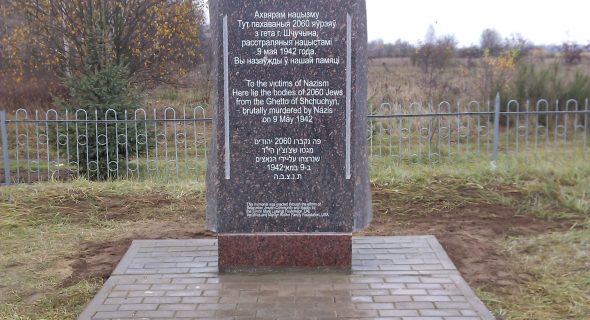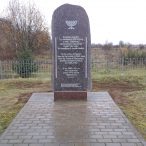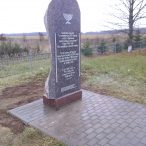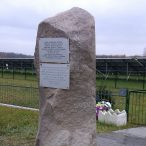From the Jewishgen Yizkor Book for Szczuczyn:
Slaughter and Holocaust in Souls and Property.
Evidence from Moshe Schneider and Yaakov Mazovetsky (Shtutshin), Golda Butrimowitz (Ostrina) Yisrael and Schraga Zluchovsky (Belitsa)Entrance of the Germans
The first unit of the German army entered Shtutshin on 26th June 1941, the fourth day since the start of the belligerent attack of the Nazis on the Soviet Union. This unit entered from the direction of Rozhanka. There, this unit shot eighty Jews under the pretext of “armed resistance”. In Shtutshin, the Germans made do with arresting a few tens of town dignitaries as hostages to ensure quiet behavior. These dignitaries were held for three days and released to their homes.
The Germans set up a local council and police force from among the Polish population; the brothers Kotzut (construction workers); the Novick brothers (teachers); Yozhvaski and Naomchik (clerks); Piltzky and his sons (the Fire-Station Guards and the “Shabbess-Goys” for the Jewish population). They served their new masters willingly and wholeheartedly during the whole period of Nazi rule in Shtutshin. They were among the main rioters and murderers during all the slaughters of the Jews in the Ghetto.
The German Command, which established its government over the town and its environs, appointed fifteen to twenty military and civilian personnel. They located themselves on the area of the “Palatz” farm, owned by the Count Drutsky-Lobatzky, at the northern extremities of the city. After getting organized there, the Germans set out on their first “hunt” in the streets of the town, grabbed one of the sons of Moshe Boykelsky (whom the Poles pointed out as a “Communist”), and hanged him in the market square.
The “Yudenrat” and the Jewish Police
At the beginning of July 1941, the Germans appointed a “Yudenrat”. The Yudenrat office was in the Puria house (Grodno Street), while the Police office was in the Rotman house (Vilna Street). The Yudenrat’s function was to fulfill, with the aid of the Jewish Police, precisely and quickly, all the German demands regarding money, food, clothing and footwear, metals (gold and jewelry). They had also to enforce the order that every man and woman over the age of sixty would do work for the Germans, without pay, of course.
These institutions were also forced to take on the responsibility of enforcing “administrative” orders. These included wearing the yellow patch while walking in the street, not being on the streets except at the hours expressly allowed, not to come into contact with the non-Jewish population, not being seen at the market, and not going out of the boundaries of the town. Despite these restrictions, the Jews maintained contacts with the non-Jews (at first) and exchanged clothes and expensive goods for food. During this period, each family still lived in their home. They were also comforted by illusions/news that the Russian armies would return within the next few weeks…
The First Slaughter and the Closure of the Jews in the Ghetto
Illusions started evaporating when, one day in mid-August 1941, the Germans picked out forty Jews from those working near the “Palatz” (digging defense posts against air attacks). They executed them all and buried them on the spot. Among those killed were Herzl Medlinsky, Leib Levin, Yaakov Vitovsky, Asher Yantchuk and others.
About a week later, a published order closed the Jews into a ghetto within a restricted area covering the following streets: Rozhanka Street and Railway Street; the market area to the Power-station; the two streets of the “Pliant“; Grodno Street and Vilna Street; and the market area to the non-Jewish “Mieshtchanes” houses. In this way were the Jews evacuated from the Market Square, where the best houses were. So, around them, a ring of antagonistic Christian and Pravoslavic population was created which enclosed them from all sides. (For this reason, the Germans did not bother surrounding the Ghetto with an artificial wall). After all the Shtutshin Jews (about 2,500 souls) were concentrated in the Ghetto, another five hundred souls were added. These were Jews whom the Germans had deported from the surrounding estates and villages, as well as from the nearby town of Rozhanka and the further-away town of Belitza. All these were accepted by the Shtutshin inhabitants as brothers-in-trouble and were well received, despite the terrible overcrowding that already existed in the Ghetto and the shortage of foodstuffs that got worse day by day.
Destruction of the Intelligentsia and Religious Leaders
About two weeks after the closure of the Ghetto, the Germans ordered the local (Polish) Police to assemble, “for purposes of registration”, all the Jewish intelligentsia (teachers, doctors, etc.), the Rabbi and those who had at any time worked in the religious field (“religious leaders”), all with their families. About ten families, totaling about fifty people, were gathered (including Rabbi Yechiel Michal Rabinowitz, the ritual slaughterer Leib Zarenstein, the teacher and slaughterer Yaakov Abramsky, the teachers Yosef Eliyahu Zhamodsky, Yitschak Tatchmowsky, and Yaakov Hachek, and the dentist Lisa Dvortsky-Sapir). The Germans led them out of the city to the outskirts of the village Topilishky (about 8 kms. from Shtutshin) and executed them by shooting them next to pits that previously had been prepared. Eyewitnesses from among the villagers who saw killing later reported that the Germans left the slain wallowing in their blood next to or in the pits and did not cover them with dirt until the next day. As a result of this, Yaakov Abramsky found himself, after recovering overnight from shock, not injured by the bullets. He returned the same night to the Ghetto and told what had happened. He also wrote about the happenings on that day in a diary that he kept about the rest of the events in the Ghetto until its final destruction (9th May 1942). Yaakov Abramsky and other people were then shot in the streets of the town, when they tried to escape from the lines of people marching to the vale of mass slaughter.
The Last Three Months
During the final three months (February – May 1942), the Germans increased the economic and psychological pressures in order to suppress the foundations of human sentiment and every spark of hope and to replace them with deep despair and loss of all hope – as preparation for “The Last Day”. The Polish policemen, appointed over the Jews during their work outside the Ghetto (mainly at the Rozhanka railway station, where they set out every morning at dawn and returned late at night) scorned and ran wild uninhibitedly. Germans in various positions and their Polish (NOTE: Very few of the Belarussians, who were the majority of the non-Jewish population, willingly joined the collaborators with the Germans.) helpers broke in daily to the Yudenrat office and announced work-levies and property-levies, demanded gold and silver, and claimed furs and jewels. The Germans goaded the Yudenrat members and policemen with threats to fulfill all the demands and claims meticulously and quickly.
Despite the bitterness that people felt against these two “Jewish” institutions, that were exploited by the Satanic authorities as an operational tool for plunder and suppression, a general Ghetto-wide awareness existed that they carried out these things impartially and did everything within their power to relieve or to hel[Page The Yudenrat organized a medical service within the Ghetto area and cared for medical first aid. It also supplied portions of hot soup to the ill and the weak from the public kitchen that it set up for this purpose. Those working at setting up and operating this kitchen were Yisrael Zluchovsky (one of those banished from Belitsa), Shalom Vitinsky, Rivka Friedman, and one of Stanitsky‘s daughters (Lesnik‘s wife). These four were a sort of feeding committee attached to the Yudenrat. They also took care of sending food parcels to the Shutshiners who had been enlisted in the “Todt” work camps in Lida. Ghetto inhabitants even told that Chaim Leib Lidsky, the Chairman of the Yudenrat during the last three months, registered his sons first in line for all hard labor assignments. He was also the first to bring the objects demanded by the Germans. He once endangered his own life when he did not fulfill the local police chief’s orders to bring Shlomo Butrimovitz’s two children (a girl aged six and a boy aged four) to the police. Butrimowitz and his wife, Tsvia, were shot after they had hidden their cow outside the town. Shlomo Butrimowitz had given his cow to a farmer in one of the nearby villages and used to go there at night to bring some milk for his children as well as for members of his family who were ill. One of the farmer’s neighbors informed. This was how Shlomo Butrimowitz was caught and executed, together with his wife.
The same day, The Koppelman couple (one of Yossel’s sons) also was executed for bringing a few potatoes and a loaf of bread into the Ghetto that he had bought from a villager in the area. The murderers also demanded the blood of the children and ordered the Yudenrat to bring Butrimowitz’s two infants and Koppelman’s three children (two daughters and a son). After Chaim Leib Lidsky refused to bring the children, the Polish police forced three Jewish policemen, (Simcha Marshinsky and two non-Shtutshiners) to do this. They also delayed fulfilling the order. The Polish police thus collected the five children by themselves, as well as the three policemen, and executed them all in the yard of the Polish police station.
The aforementioned Chaim Yossel Koppelman was shot a few days later, on Saturday, when he went out from his house for a moment and looked outside. [Note: In Chaim-Yossel’s house (one of the Gabbais of “Chayai Adam” synagogue and a well-known and sought-after prayer leader), a minyan was held during the Ghetto period, under the leadership of Avraham Yakov Losh, who died of natural causes a short time after the destruction of the Ghetto.] Suddenly, Germans appeared before him [?]and shot him immediately. They turned around immediately and shot a second time at Itsche Yankel Schneider, who happened, by chance, to be in the same place.
The Germans entered the Ghetto area on that Saturday with the aim of finding mothers with many children and murdering them with all their children. They found Sarah Rabow, daughter of Monas Lidsky, and murdered her. When they did not find other mothers, they aimed their rifles at any Jewish soul that crossed their path. They progressed with slow steps along the Ghetto’s Railway Street. From time to time, they turned to a house or a courtyard (as if checking the sanitary situation), took their victims out to the street and shot them.
On that Saturday, about twenty Jews were murdered – men, women and children. Amongst them were Bezalel Koppelman, the second son of Chaim Yossel, as well as Feigel Mekel and David Zluchovsky, who were in the same apartment. The bodies of those murdered were gathered on Saturday night by the Jewish Police and taken to the cemetery. However, because of the frost and the snow that fell the whole night, these martyrs were not buried until the next day.
The Last Sabbath — 22nd Iyar, 5702
For reasons of malice and hatred, the Germans set the Sabbath as the day of killing and extermination. Thus, the above-mentioned killing also took place on the Sabbath, as a sort of general “rehearsal” for the last Sabbath of total liquidation of the Ghetto inhabitants – the Sabbath of Parashat Bahar-Bechukati, 22nd Iyar 5702 (9 May 1942).
Two days previously, the Yudenrat was given orders to close all exits from the Ghetto completely and to oblige everyone to immediately hand over the remainder of their gold, silver and jewels. The following day, (Friday, 8 May), a group of villagers was seen outside the Ghetto, equipped with digging implements. S.D. men led them to the “new” Jewish Cemetery. For some reason, this news was not comprehended within the Ghetto and the people, who were sentenced to death, slept their last sleep without any special shock.
On Saturday, 9 May, during the early hours of the morning, the members of the Yudenrat and the Jewish Police numbered the houses and, under orders of the authorities, announced a gathering in the synagogue square for the purpose of a general population census (including children and the ill). When the whole community gathered, the German Shteibes-Leiter, Windisch appeared with his assistant, the Pole Vasiokevitch, from the Gebiets Komissariat in Lida; the local police commissioner Kotsut and the head of the local council Yazhevsky (both of them Poles); and a group of about twenty-five S.D. machine-gunners.After the lines of those assembled closed ranks in order (by family), the local police commander announced that the plan was to choose five hundred men (with their families), artisans and workers, who would be transferred to Lida. The others would be dispersed to their homes. When this group had been assembled (including some of the members of the Yudenrat and the Jewish Police), the people of the assembly were allowed to march to the Market Square, where they were ordered to lie on the ground with their faces downward, heavily guarded by the Polish police.
In the meantime, a group of German motorcyclists appeared in the Synagogue Square, armed with sub-machine guns. They started shooting into the crowd. An order was given to move while the murderers surrounded the rows from all sides, shooting non-stop and directing those sentenced to the outskirts of the town towards the pits which had been previously prepared. There waited a firing squad of Lithuanians and Latvians, who had previously performed the same “execution” in the other towns of the Lida region. The people who were led to the pits were ordered to undress, to put their clothes aside, and to enter the pits. The murderers showered them with machine-gun fire and threw grenades into the pits. They, then, covered the dead with a layer of chloride and prepared the others for “execution”. This carried on until 5 [Pagem. Shtabes-Leiter Windisch, who had been with his escort the whole day at the place of execution, appeared before the Jews, who had been lying face down all that time in the Market Square, and declared the following: “Jews in Lida stole arms from Germans. We have therefore killed all the parasitic Jews in the whole region. If you behave according to the law and work efficiently, you will all stay alive…”. The following day, the Jews were given permission to gather the bodies left lying since the previous day along the route from the Synagogue Square to the Valley of Death and to bury them next to the common mass grave.
Thus, the Hell of Doom in Shtutshin was filled with 2,060 holy bodies of men, women and children, the people of Shtutshin and Rozhanka (and surrounding villages) and Belitsa, who rose on the fire of abomination on that “Holy Sabbath” of the 9th May, 1942.
After the Great Killing
Those same five hundred Jews who remained alive, returned to the Ghetto and all settled down in one street of the “Pliant” (the Grodno side). The Yudenrat was reformed. The public kitchen was reopened. The public bathhouse, which had been abandoned for a long time, was rehabilitated. A Minyan was organized in a permanent prayer house. Even an underground “Cheder” was organized for about thirty orphaned children, without father or mother, who had arrived with the remnants of the murders in Vasilishki, Zholudok, Radin and other towns. The mass executions had occurred in these places as well during the first half of May 1942.
The Jews received four carts with horses for taking out the accumulated rubbish from the Ghetto. These carts were also used for bringing food from the nearby villages, for the use of the public kitchen under the management of Yisrael Zlutchovsky (from Belitsa). The new German “Zondefuhrer”, who was appointed over the town, was prepared, for bribes, to allow the Jews to work the gardens next to their houses or even to gather crops in the village fields belonging to Jews in Kolonna, who had all been butchered in Shtutshin. However, this situation lasted for a few months only. The Germans then realized that things had calmed down since the shock of “The Last Sabbath” and that it was possible to use this human dirt for hard labor. In September 1942, the Germans started organizing groups of people and sending them to the “Todt” Work Camps in Lida, Vileika, Krasna, Oshmana and Borisov. During the next six months, Shtutshin was almost completely emptied of the remnants of Jews. (The last Jews still there were sent to Lida in the summer of 1943.)
Among the Shtutshin Jews who were concentrated in the Lida “Todt” work camp were (some of them with their families): Chaim Leib Lidsky, Yosef Listovsky, Tsvi Marshinsky, Nachum Stutsky, Nechemia Lidsky, Yosef Tsirolnik, Yaakov Kamenetsky, Moshe Tsvi and Aharon Kamenetsky, Yaakov Matsulsky, Tanchum and Moshe Schneider, Nechemiah Khazanovsky, Arye Zusilsky, Mikal Mordochovitz, Aharon Tzvi Mazovsky, Gad Vitovsky, Chaim Zonschein, Yekutiel Bloch, Rivka Yanchuk, Chaya Raplovitz, and others.
On September 17, 1943, the Germans collected all the Jews from this work camp, put them into sealed railway wagons, and sent them to the Maidanek death camp.The train made its way along the Lida-Mosty-Volkovisk track, a track that was well known to those from Shtutshin and its environs. When the train approached the Mosty station at night and started slowing down, Moshe Schneider decided to breach the iron net, which sealed the only hatch in the wagon, and jump outside. He urged the other Shtutshiners with him in the wagon to do the same. He persuaded Meilach Vitovsky and Yerachmiel Lidsky to jump after him. These three later became partisan fighters. The first two survived, while Yerachmiel Lidsky was killed in the partisan war.
Another Shtutshiner on the same train, Chaya Stutski, was miraculously saved before she arrived in Maidanek. However, all the other Shtutshiners who were on the same train, reached Maidanek, and were killed there in the Gas Chambers.
B. War and Revenge on the Destroyers of a People
Evidence from Moshe Schneider and Yaakov Mazovetsky (and other sources)
Thirteen War Remnants
Of the 2,500 Shtutshin Jews, who were in the town or other parts of the area during the Nazi conquest, only thirteen individuals were discovered alive at the end of WW2. Amongst them were Chaya Stutsky, who had been saved on her way to the Maidanek concentration camp; Reizel Medlinsky (and her daughter), who had been disguised as Christians in the Vilna region; Rachel Katscheisky, Tsvia Bloch and Leizerke Kossovsky (as a youth), who were hidden by Belarussian villagers; and Moshe Tsvi Kamenetsky and Yitschak Rubinstein, who had been in the supply corps of the Kalinin Jewish partisan unit. (This unit had been organized and run by the three famous brothers – Tuvia, Zussia, and Eshhol Bielsky from Novogorodok). Also among them were Moshe Schneider and Meilach Vitovsky (previously mentioned), the brothers Eliezer, Tsvi and Yeshaya Tscherniak, and Yaakov Mazovetsky, who were in Soviet Partisan fighting units.



